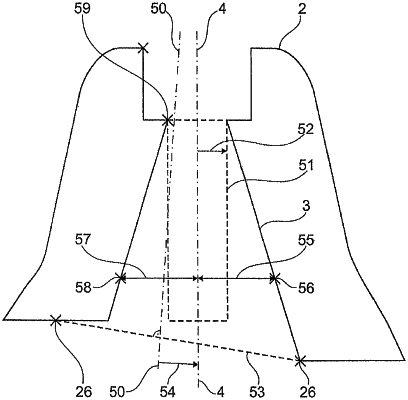| CPC A61C 13/0004 (2013.01) [A61C 9/0006 (2013.01); G06F 30/00 (2020.01); G06F 30/10 (2020.01); G06F 30/20 (2020.01); G06T 19/20 (2013.01); A61C 1/084 (2013.01); A61C 8/0068 (2013.01); G06T 2210/41 (2013.01); G06T 2219/2004 (2013.01); G06T 2219/2021 (2013.01)] | 16 Claims |

|
1. A computer-implemented method comprising:
planning a dental structure, by:
providing a 3D model of the dental structure having at least one radially symmetrical opening;
determining a provisional axis of symmetry by one of:
(a) generating a provisional reference point in the radially symmetrical opening that defines the provisional axis of symmetry to be generated, and computing the provisional axis of symmetry by generating a straight line that passes through the provisional reference point; or
(b) generating a closed curve around the radially symmetrical opening, the closed curve is not restricted to a circle, generating an interpolation plane passing through edges of the closed curve; and disposing, responsive to the interpolation plane being generated, the provisional axis of symmetry perpendicular to the interpolation plane;
computing an optimized axis of symmetry of the radially symmetrical opening from the provisional axis of symmetry by iteratively modifying a current position and orientation of the provisional axis of symmetry until a radial symmetry criterion is satisfied by iteratively moving and rotating, in a plane defined by the provisional axis of symmetry and a closest point of the 3D model to the provisional axis of symmetry, the provisional axis of symmetry such that a first inner radius perpendicular to the provisional axis of symmetry and between the provisional axis of symmetry and a first contact point on an inner side of the radially symmetrical opening matches a second inner radius perpendicular to the provisional axis of symmetry and between the provisional axis of symmetry and a second contact point on an inner side of the radially symmetrical opening in another direction, the first contact point is different from the second contact point; and
manufacturing the dental structure, using a CAM (Computer Aided Manufacturing) processing machine, from a blank based on said optimized axis of symmetry, by:
arranging the 3D model within the blank such that the optimized axis of symmetry is parallel to a central axis of a tool of the CAM processing machine; and
operating the tool to carve out the radially symmetrical opening parallel or substantially parallel to the optimized axis of symmetry to minimize forces acting laterally on the tool.
|